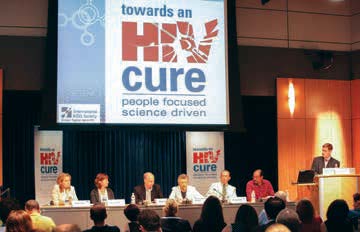This March, news broke that a child
from Mississippi, who tested HIV
positive at birth, had been cured of HIV.
Less than two weeks later, researchers
reported that 14 individuals in France
had been functionally cured of the
virus. Five years ago, the first case of
a cure occurred in an HIV-positive man
with leukemia, known as the Berlin
patient. “A decade ago, almost nobody
spoke of curing HIV infection as a
realistic goal, yet we find ourselves in
early 2013 with not one, nor even two,
but three different types of HIV cure,”
said Rowena Johnston, Ph.D., amfAR
vice president and director of research.
[Update (7/10/14): Surprising New Development in "Mississippi Child" Case]

Dr. Rowena Johnston (second from left) participated
in a two-day pre-International AIDS Conference cure
symposium in July 2012.
So what does this all mean?
According to Johnston, “Much
depends on how a cure is defined.”
Experts currently define two categories
of HIV cure. A sterilizing cure requires
the complete eradication of all HIV from
a person’s body. A functional cure
requires only that even after patients
stop antiretroviral therapy (ART), their
HIV remains in remission and does
not damage their immune system
enough to cause any adverse health
consequences.
So what does this
all mean? According
to Johnston, ‘Much
depends on how a
cure is defined.’
The French cases, known as
the VISCONTI cohort, are viewed
as functional cures. These patients
began receiving ART within the first few weeks after they became infected, a
time known as acute infection. Today
they still have detectable HIV in their
blood, but have been off ART for an
average of seven years without any
signs of disease progression. However,
the researchers noted that only 10–15
percent of patients who are identified
during acute infection and placed
on immediate treatment can expect
similarly controlled infections.
It remains less clear whether or not
the Berlin patient and the Mississippi
child experienced functional or
sterilizing cures. Trace amounts of
HIV have been sporadically detected
in both patients since they went off
treatment, but at such minimal levels
that the tests could represent falsepositive
results. In addition, research
done to date has not identified virus
in either patient that is capable of
replicating, and therefore whatever is
present does not appear to be causing
harm to the patients.
"This case has
galvanized discussion
about the potential for
immediate treatment
of HIV-exposed infants
to increase the chance
of curing them in the
future."
The Berlin patient was cured after
he received a stem cell transplant from a donor with a very rare
genetic resistance to
HIV infection, a lifethreatening
and costly
process that cannot
be recommended on
a wide scale. The
Mississippi child, on
the other hand, was
placed on ART at 31
hours after birth, before
confirmation of HIV
infection, an unusual
approach that is not
routinely practiced in
the U.S. or in other
countries. After 18 months of treatment,
it was stopped and has not been
restarted for over a year.
This was an unusual and unexpected
outcome that further research will help
to explain. Nevertheless, this case has
galvanized discussion about the potential
for immediate treatment of HIV-exposed
infants to increase the chance of curing
them in the future. “The case is a startling
reminder that a cure for HIV could come
in ways we never anticipated,” said
amfAR CEO Kevin Robert Frost.